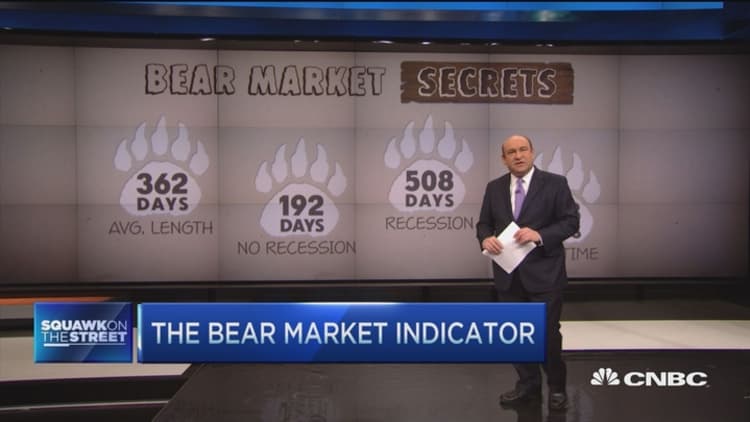
It turns out investors probably should heed those national park signs warning hikers to "Beware of Bears."
In a 1966 Newsweek article, the eminent economist Paul Samuelson famously quipped that the stock market had predicted nine of the past five recessions. It's a remark that is often repeated to deride the powers of the stock market to predict the economy.
CNBC went back to see if Samuelson was right and, if so, does he remain right? As the gauge of the market, we looked at all the bear markets of the postwar era, using data compiled by the financial research firm Bespoke, where stocks fell 20 percent, stayed down for longer than a month and where there was no 20 percent rally.
Before getting to the current results, the first thing we found is that Samuelson was technically wrong, but right in spirit. Using data from his day, he actually understated how lousy the market was at predicting recessions, at least by the standards we employed. When Samuelson wrote in 1966, the market was nearing the end of an eight-month-long bear market, one that would not lead to a recession. In fact, the previous nine bear markets starting in 1966 led to just three recessions.
The current results show Samuelson's quip was spot on. There have been 13 bear markets in the postwar era. These 13 bear markets have led to recessions seven times within about 12 months. So instead of Samuelson's 9 of 5 (think about it like shooting 55 percent), it's really 13 of 7 (53 percent). Pretty impressive for a quip.
(Down about 10 percent from the highs, the market remains a long way from our bear market recession indicator, though economists have been raising the probability of one.)
On average, bear markets give investors about eight months of warning that a recession is on the way. That is, the average recession after a bear market doesn't begin until 253 days later. But there's a wide range: The 2007 recession began just 53 days after the 2007 bear market began. But it took 367 days before the November 1968 bear market yielded to the 1969 recession. (We counted that as a success for bear market predictions because it was only two days outside of the one-year limit).
The research also shows that there's a way — however imperfect — to distinguish between ordinary bears and scary bears that predict recessions. The longer the bear market lasts, the more likely it is to presage a recession. A bear market that causes a recession lasts 508 days on average, paced by the January 1973 bear market that lasted 1.7 years and led to the November 1973 recession.
This, of course, raises the question about whether bear markets do more than just predict recessions. Do they help cause them? The idea that longer bear markets are more likely to predict recessions provides some evidence that lower stock prices for longer play a role in eventually bringing down the economy.
Lower stock prices can lead CEOs to pull back from investment and hiring. They can also lead to less consumer spending as the stock market kicks off less of what economists call "the wealth effect." And they could lead households to save more. It's worth noting, every bear market that preceded a recession was still around when the economic downturn began.
And it isn't as if all the selling happens in the bear markets that precede the recessions. The record clearly shows that once recessions begin, markets can fall further.
Ultimately, CNBC research raises questions about Samuelson's quip in the first place. In any given year, the economy has a random chance of being in recession about 20 percent of the time. But if it's 9 out of 5 or 13 out of 7, it's right more than half the time. A gauge that offers a success ratio greater than 50 percent is better than a so-called random walk.
Lew Alexander, U.S. chief economist at Nomura, who has written at length about a recession probability, said Samuelson would not disagree that the stock market contains useful information on the economy. But he said Samuelson's main point (at least the way other economists think about it), is that there is a lot of volatility in financial markets but the underlying economy is much steadier. Alexander said decades of economic research show that you cannot explain movements in the economy from stocks.
And it helps explain why Fed officials keep a watchful eye on markets but are loathe to take definitive cues about the economy from the stock market and alter policies with every downdraft.




